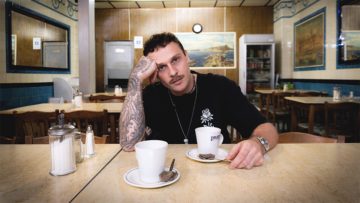
By now, we’re familiar with how TikTok is shaping the music industry. As the reason behind most of the biggest tracks in the last few years, it’s been on the cutting edge of pioneering new artists and genre takeovers. But now it seems like it’s kicked into reverse, returning us to the folk scene and the heyday of the lyrics. Re-centring words are the most critical thing. Indie-folk singer-songwriters are having their moment, with a new heart-wrenching demo dominating weekly. From Katie Gregson-MacLeod’s track, ‘Complex’, which has racked up over 13 million streams in just over a month, to the as-yet-unreleased ‘The Giver’ from Sarah Kinsley, it seems the soundscape of the app is shifting.
It’s a dramatic shift. Consider the main tracks we would associate with TikTok, such as BENEE’s ‘supalonely’ from the 2020 lockdown or Piri + Tommy’s ‘Soft Spot’; upbeat pop or dance tracks. Initially, a place for American influencers to do the work to whatever trending sound. It’s sometimes terrifying the power TikTok has on the music industry.
The focus on upbeat tracks makes sense on an app where the average video is under 15 seconds long. As we saw with the trend of sped-up songs blowing up, TikTok demands immediate satisfaction and low effort levels. Users want the immediate payoff, something instantly hooking that doesn’t challenge the short-term attention span the app caters for – an apparent reason why dance and pop tracks have previously succeeded on the platform.
But brewing in the underbelly, somewhere between cottagecore and sad girl autumn content, there’s always existed a corner of the app dedicated to songwriting. With the consistent trend of musicians creating videos inviting others to write their own verse and more established songwriters, including Lizzy McAlpine using it as a place to share early demos, artists like Grace Gardner have always had a spot on the app, even if she didn’t go viral. But now, with her track ‘Deny Me’ gaining over 500k views on even the first teaser of the first verse, that quiet corner is getting much bigger and much louder.
“I think I posted it at like 11 o’clock one night and then went to sleep,” she said. “When I woke up with a lot more traction than I’d usually get, I think it was at around 10,000 views, I was like, wow, okay. But then two days later, it was at 250,000 and the day after it kept going up. It started getting traction, and people started covering it without a week, and then their videos were getting traction. It was this kind of domino effect.” Writing her own lyrics over an instrumental posted by another user, the video is relatively unassuming and visually uninteresting. Sitting in a dark room, hunched over her guitar, is the opposite of what we imagine as a viral video. There is no immediate hook-in, nothing visually grabbing, and no trending sound added; it would baffle any social media expert. But something about the opening line of “I get this twisted and sickening feeling I’m gonna marry you,” had people locked in.
@gracegardnermusic Replying to @gracegardnermusic here’s verse 2 of deny me bc I just love u guys so much PRESAVE IN BIO 🫶🫶🧑🌾 beautiful guitar from @citizenpapes !! #denyme #gracegardner #singersongwriter #songwriting #songwritersoftiktok #originalsong #newmusic #lizzymcalpine #acoustic #sad #breakup #unrequitedlove #fyp #sadgirlautumn #sadsong #lovesong #folk #indie ♬ original sound – grace gardner
The reaction to Grace’s track immediately mirrors the story of ‘Complex’. Katie’s original video is unassuming, a simple shot of her face filmed from her piano, but the lyrics “I’m wearing his boxers, I’m being a good wife” set people spiralling. Within days, artists like Lennon Stella, Fletcher and James Bay had offered their versions, and Columbia signed Katie to Columbia off the back of a one-verse demo. So far from what we’d expect virality to look and sound like, the shift is the latest in a series of strange moves in the ever-evolving TikTok soundtrack, but it makes more sense than you’d expect.
“I mean, heartbreak resonates with people”, Grace offers up as a reason why she thinks ‘Deny Me’ might have blown up. “I found more and more comments would come in with people interpreting it in so many different ways. Many people used it as a comfort song to heal from their heartbreak experiences. But many people also said it reminds them of their relationship and how much they love that person.” Delivering these videos directly to your phone, the emotional intimacy we apply to our favourite songs seems doubled here. In the same weird way that your ‘For You’ page appears to know precisely what you’re up to (offering restaurant suggestions in your home city or somehow knowing any life woes you’re going through and delivering you relatable content), we treat our algorithms as something deeply personal and utterly specific. Curled up on your phone in the middle of the night, going through the throes of heartbreak, you’re in your most vulnerable and open state to connect to a new song. And if you’re going through it and a lo-fi demo video like Katie’s or Grace’s lands on your FYP, singing your feelings back at you, it feels heaven-sent, like some sign sent For You.
View this post on Instagram
But beyond the personal and emotional, part of the rise of sad girl songwriting on the app may well be down to a simple feature. Uniting all of the significant tracks taking off is the in-app text feature adding the lyrics onto the screen. The videos are relatively dull, so you’re far more likely to read the words than watch them. Grace said, likening it to having subtitles on for Netflix, “I originally started doing it for accessibility, but I think the first time you listen to something, the words can get kinda muddy. This lets you really absorb what the song is saying.” Reading the words will naturally harvest a more personal connection by spotlighting the artistry and literature behind lyricism.
“It also makes it feel so much more connected to the artists and their craft because you realise how tied to it they are when you see exactly how they wrote those lyrics down”, Grace added, “it’s like they’re a poet.” Displaying the lyrics more like a poem to read and analyse than a song to listen to, this introduction to the music with the lyrics at the forefront seems to force you to pay far more attention to the meaning than you ever would on a Spotify shuffle. Immediately letting you develop your understanding of it, or at least allowing you to sing along instantly – maybe it’s a recipe for a hit.
Regardless of its reasons, this sudden wave of acoustic hits coming from TikTok is an optimistic move. Expanding the musical landscape of the app, there’s no longer a precise one-size-fits-all shape, demanding upbeat, easy tracks from musicians crafted for catchy virality. Grace said with the perfect concluding thought, “I’ve always been a lyricist first, and this moment makes me feel really optimistic. Seeing so many people valuing the deep lyricism that we spend so much time on trying to find the perfect delivery – it makes me feel hopeful.”




